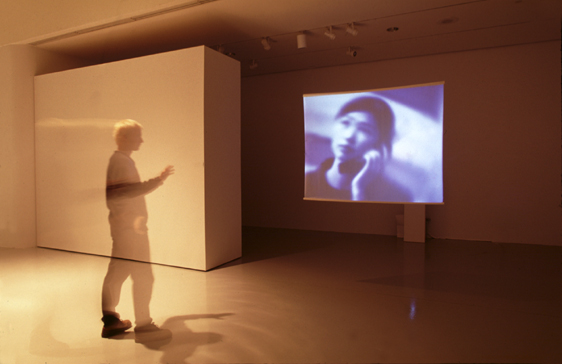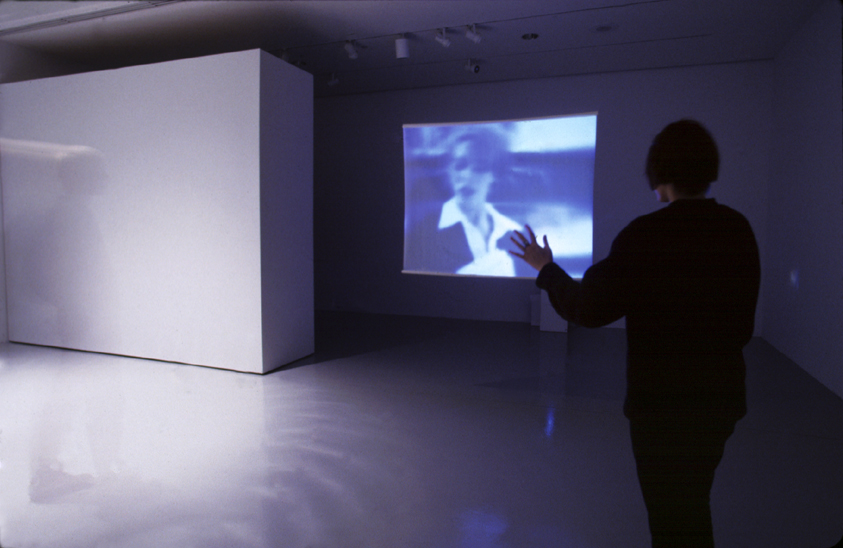[corporate ladder]
Projection, software, sensors, computer
dimensions variable
2000
A physical computing based installation, [corporate ladder] is a changing commentary about alienation in corporate workforces. As participants move closer and close to examine the canned images of women using technology or performing business tasks or positions, the images blur, problematizing the notion of legibility in these roles.
How would one as an artist examine women’s roles in the workforce, and in particular, the relatively overlooked phenomenon of women in corporate jobs? How is it possible to examine or recreate phenomenon that women experience daily? Take for example the still problematic social phenomenon of the glass ceiling.
The numbers of women corporate officers in US was 10.6% of the workforce in 1997 (Business Week 44).1 For many women managers in these settings, there seems to be an invisible — and impenetrable — barrier between women and the executive suite, leaving them at the peak of their careers at a significantly lower levels than those of their male counterparts. While management may seem like a golden spot for women struggling for their career dreams, the experience of being a woman in management is under-explored in critical and creative spheres. It is a seldom-discussed experience in which the subtleties of authority, self-esteem, control, and glass ceilings manifest in their most deviant and deceptive ways.
Far from a rewarding career, a management position can be the site of a very fierce struggle for identity. The federal Glass Ceiling Commissions’ bipartisan study in 1995 found that although some positive steps are being taken, the glass ceiling essentially was intact. Minority men and women of all races are not well-represented in the upper ranks of the companies reviewed compared with their overall numbers in the workforce. (Castro and Furchtgott-Roth, 1997).2 While it seems that the feminist movement has achieved a victory by opening doors to women in upper level positions, a deeper examination reveals that this goal has not yet been fully achieved.
[corporate ladder] is a computer-driven installation which explores women and work through images of women in corporate settings. The user moves through a physical space toward either a projection or a monitor displaying images of women working in corporate environments. As the participant approaches the image, the image incrementally becomes blurred, and by the time the user is close to the piece, the image is eradicated, switching out to another series of work images. Thus, visitor/participants directly influence the images they see or cannot see by their proximity to the images of the women. When they are close to the image, the images becomes untraceable and indefinable; the user is positioned in a kind of visual glass ceiling.
The project focuses on images of popular representations of women’s bodies– the interface for work– in their offices and cubicles, engaged with the technology around them. The goal of this piece is it is to put the user inside the tension women have maintaining multiple and opposed identities as corporate worker, the image of the corporate worker, and self.
[corporate ladder] is part of a trajectory of my technological exploration of women’s experiences. The goal of my artistic practice is to develop interactive environments which feature material and explore issues largely ignored by “technoculture.” These have included women’s stories, narratives of aging, and critical investigations of the computer as a medium itself. [corporate ladder], an interactive installation, allows me to approach the content with novel strategies in interface to examine women’s work.
- Business Week. “Perforations in the glass ceiling.” Dec 22, 1997 n3558 p44(1).
- Castro, Ida L. and Furchtgott-Roth, Diana. “Q: Should women be worries about the glass ceiling in the workplace?” Insight on the News. Feb 10, 1997 v13 n5 p24(4).
Exhibitions
- Digital Arts + Culture International, Atlanta, Georgia, 2000
Press
“Kvindelig ledelse findes ikke.” Features installation from “digital mediekunstner Mary Flanagan, “Corporate Ladder.” Forum for Kon og Kultur (Forum Online Magazine from Denmark). 13 November 2000

